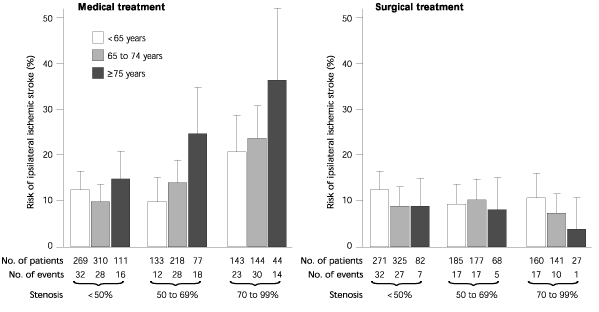
Am Fam Physician. 2001;64(10):1749-1750
Strokes are a leading cause of death and disability in older patients. For each decade after age 55, the risk of stroke doubles for men and women. The major cause of stroke is large-vessel atherosclerosis, with the highest risk occurring in patients with stenosis of the internal carotid arteries. After considerable research, a consensus has developed that the optimal benefit of carotid endarterectomy is in symptomatic patients with at least 70 percent stenosis. The benefit of this surgery in elderly patients remains controversial because of the high incidence of comorbidities plus the increased risk of perioperative stroke or death. Alamowitch and colleagues studied the benefits and risks of carotid endarterectomy in patients 75 years and older in a large multicenter clinical trial.
Eligible participants had to be medically stable for endarterectomy, have 30 to 90 percent stenosis of the internal carotid artery on angiography and have experienced transient ischemic attack or nondisabling ischemic stroke within 180 days of entering the study. Patients with a life expectancy of fewer than five years, those with other potential causes of thromboembolism and patients with uncontrolled diabetes or hypertension, unstable angina, progressive neurologic signs or myocardial infarction within six months were excluded. The 2,885 participants were randomly assigned to optimal medical care or optimal medical care plus endarterectomy. All patients were assessed by a neurologist every four months. Outcome measures included occurrence of stroke within two years, degree of disability and radiologic measures of stroke severity.

Patients treated medically showed increasing risk of stroke with age and degree of internal carotid artery stenosis (see accompanying figure). The degree of stroke risk reduction with surgery was also found to vary with age and degree of internal carotid artery stenosis, but the oldest patients demonstrated the greatest benefit and had the lowest rates of perioperative complications. In patients with more than 70 percent stenosis, the stroke risk reduction and perioperative risk of stroke and death were 28.9 and 5.2 percent for patients older than 75 years. In those aged 65 to 74 years, the comparable figures were 15.1 and 5.5 percent, and in patients younger than 65 years, the stroke risk reduction was 9.7 percent and the perioperative risk of death or stroke was 7.9 percent. In patients with stenosis of 50 to 69 percent, the risk reduction for stroke within two years was only statistically significant in patients older than 75 years.
The authors conclude that, in patients older than 75 years, three surgeries would have to be performed to prevent one stroke within two years for stenosis greater than 70 percent and six surgeries when the stenosis was 50 to 69 percent. The greater benefits seen in this select group of patients were attributable to the fact that they were less likely to have a history of risk factors, particularly cigarette smoking. The small numbers of women in the various subgroups did not allow conclusions to be made about the influence of gender on outcome. The authors conclude that carotid endarterectomy can provide substantial reduction in stroke risk in select elderly patients.